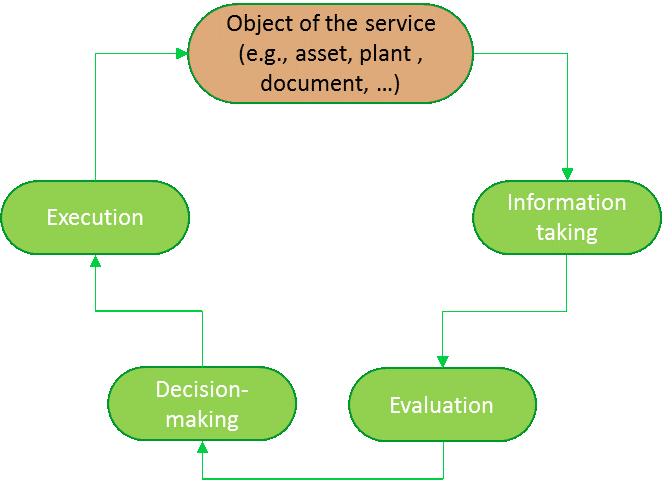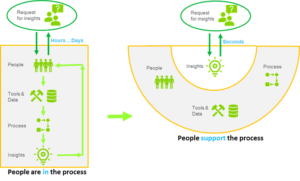This is the fourth blog in our Digital Transformation series. The first post lays the groundwork for how companies can leverage technology, processes, and people to establish a new way of thinking. The second post discusses customer goals and expectations for digital transformation. The third post explains the importance of choosing the right people to drive digital transformation.
Today, most industry observers agree that the digital transformation of mining, manufacturing, water / wastewater, and oil and gas industries represents an immense opportunity to create value for both industry and society. Although many assume that technology lies at the core of digital transformation, in fact, more than just technology is required. It is also about the people within organizations who wish to break new ground, create new value for their customers, and accrue the promised benefits. In fact, true digital transformation requires a combination of simultaneous modifications to technologies, processes, and people to establish a new corporate mindset.
For most industrial stakeholders, the primary method for achieving digital transformation is to optimize existing processes so that operational efficiencies and industrial outputs can improve. However, this view provides limited, potentially temporary benefits and improvements. A focus on optimization of existing processes misses out on the true potential of a long-term reinvention of the organization, a strategic move that greatly enhances the business’s prospects for long-term survival, expansion, and profitability.

Understanding People’s Cognitive Processes is Key to Digital Transformation Success
In this blog, we answer some of the most common questions that our customers ask about the role of people, systems, and processes in corporate digital transformation initiatives. We also explain how a business can be transformed to achieve new efficiency levels with a clearly articulated business strategy. In addition, we illustrate a methodology that we at Schneider Electric use to help expedite and exploit digital transformation benefits across industrial organizations.
Q: For an organization undergoing digital transformation, what should the corporate leadership hope to achieve from a people perspective?
A: The goal is to improve the cognitive experience of people when they are engaged in work operations. This includes the elements of mental interactions, pleasure, displeasure, satisfaction, and frustration that they derive from their current work. The notion of cognitive augmentation is quite central to our digital transformation approach. To establish their cognitive augmentation, we work with key personas within the organization and value chain — such as engineers, operators, controllers, and sales representatives — to determine how they receive and evaluate information, make decisions, and then act. This sequence of mental operations is called cognitive loop processing; see Figure 1.

Besides considering the cognitive experience of people from an information processing perspective, we also closely examine the human emotions involved and how they connect with cognitive processing. At the root of this persona-centric analysis exercise is the identification of the elements that define the exceptional persona experience for us. Based on this multi-dimensional vision we can determine what information people in the manufacturing value chain need to make the right decisions and how we can augment the user to make the best, safest, fastest, most efficient, and most reliable decisions in all cases. After this first purely persona-centric step, we then determine what outputs each of these personas is expected to provide to others within the organization and derive interdependencies and information flows between the personas. In this way we improve the cognitive and emotional experience of both the personas and also the organization in a holistic way.
Q: What do you hope to achieve, from a business perspective, by investigating different personas?
A: As mentioned before, the central issue is how to help people make the best decisions in a more and more connected and complex environment. For business to thrive, a mix of augmented, connected, and expertise-focused platforms will be needed to provide the worker of the future with the knowledge to create an agile environment. Twenty years ago, we used paper maps to drive from point A to point B. Today we use augmented platforms (e.g., GPS navigation systems) that expand each cognitive step involved in the navigation process. These tools provide us with the best option for driving from point A to point B. This same thinking can apply itself to the augmentation of industrial processes.
We find the most effective way to bring digital transformation into an organization is through the cognitive augmentation of its people, processes, and systems (aided by technology platforms). What we mean by cognitive augmentation is the improvement of people’s decision making, information intake, and ability to evaluate situations. This goes way beyond a traditional “automating their jobs” view.
Our approach is people centric and aims at enhancing their experience through technology and platforms. As augmentation matures in the company, people can begin to transition their focus to managing exceptions to the normal process, or to providing individualized services to customers or others. These are the facets of each augmented role where the abilities of the human brain play a key role. This transition is not an overnight process. Several preliminary steps are involved. These include the integration of different persona inputs (information access) and outputs (services provided) to each other (see Figure 2) through platforms that mediate these interactions and service exchanges. They also involve the development of smart agents (technology programs) that act on behalf of the processing system and personas to execute and augment everyday tasks (i.e., an engineer notifies an operator that it is time to test a particular line machine).

Figure 2. Achieve Timely and Augmented Knowledge
Q: What is the participation level of the people involved and how are they impacted by the transformation changes?
A: It’s important to highlight that the process is executed through a participative design process, not a data gathering session. The people directly take part in the design of their future solutions. The first step is ideation, which is key for the scene setting. It’s about what the future might look like and it avoids sticking to the “as-is”, which focuses on optimization, not transformation. This means that the participants start their transitional journey to a transformation mindset, a connected mindset, a mindset which goes beyond the silo that they currently operate in. At the same time, they improve their environment by making the best decision each time, in close and connected collaboration with others.
The people involved gain a better comprehension of their role in this new world, and understand how the approach they are currently familiar with will change – for the better – to achieve the corporate digital transformation goals. They also gain a much deeper understanding of the others around them who will influence their decisions, their output, their services, and what services those other individuals will be providing to them. The management team gains an adjustable roadmap and comprehensive data model of the whole digital transformation process. Management can visualize what will be in front of them over the next several years and determine which of the personas they want to start with, in their digital transformation process, and where best to place their initial digital transformation investments.
With People at the Center, Digital Transformation Initiatives Can Succeed
Today it is the people who make all decisions and the technology that plays the decision support role. This will be the same tomorrow. People will continue making all critical decisions supported by augmented technologies. Therefore, by going back to the basics, and understanding how people make decisions, how they acquire and evaluate information, and how they then act based on this information, corporations are in a position to improve their everyday holistic work experience, and incorporate people augmentation into their business strategy.
The real challenge for companies is to come up with a new way of rolling out a digital transformation journey. A traditional roadmap works well for maintaining business silos and for working within a context where the physical world, with all its constraints, is acceptable.
However, executing a true digital transformation strategy is difficult when siloed thinking is a hindrance, when siloed projects fail to benefit others who are outside the silo, and where standalone roadmaps fail to create the expected business outcomes.
The ability to articulate a transformation strategy for each individual person involved is a key first step, but the transformational journey doesn’t end there. Be ready to rethink the way you map out the journey so that you can achieve the dual goal of an improved person-specific and organizational-wide experience.
Take the Next Step
To learn how your company can embark on a journey that embraces true digital transformation, contact Rik De Smet or Denis Javaux.
CNN Indonesia published a Digital Transformation article co-authored by Rik and Farid Belbouab, CEO of shipping company Meratus. Read the English version here.




Conversation
In this blog I came to understand about the Process Data Transformation. I totally agree with this blog, without people we cannot find the transformation in an organization/project/process and it will take a long time to attain that transformation. Together with technology we also need to address the folks who are involved. Such a valuable blog which makes us understand the value of people beside technology.